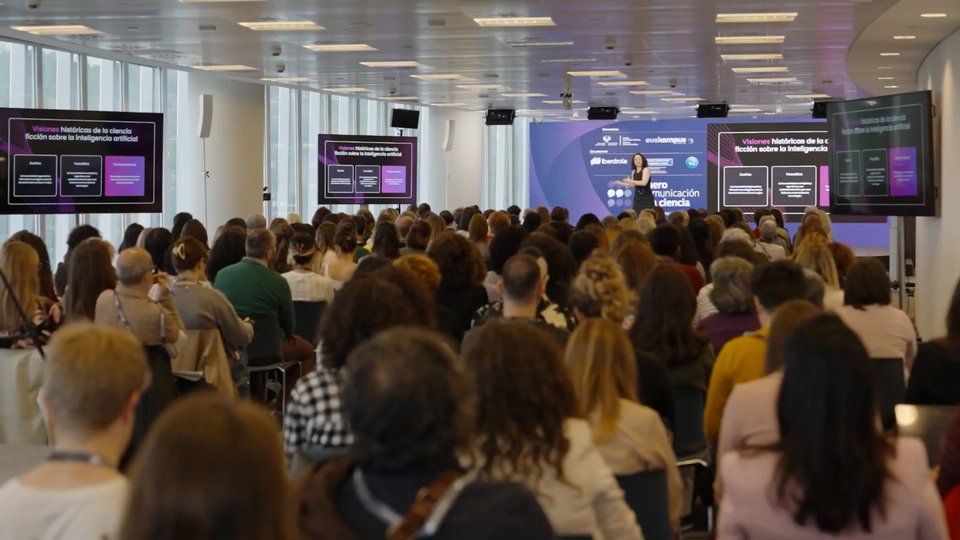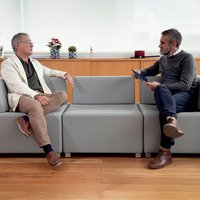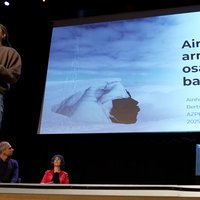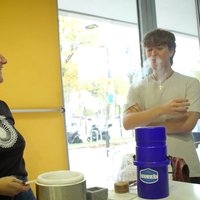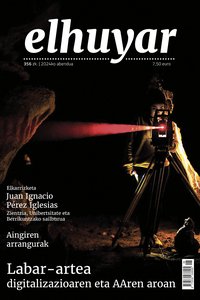Fungi, biofilms and human diseases
01/12/2008 | Alvarez Busca, Lucia | Elhuyar Zientzia Komunikazioa

Immunofluorescence of the fungus Candida on the left and biofluorescence.
G. Quindós
Medical mycology studies the interaction between fungi and man. The Mycological Medicine research team, led by Guillermo Quindós, investigates serious fungal infections, such as invasive candidiasis and aspergillosis. These are effective tools and treatments for the diagnosis of these infections. In fact, it is currently difficult to diagnose these infections due to the lack of adequate tools and ignorance of the factors that cause pain in the fungi.
In patients admitted to hospitals, fungal infections – through catheters, needles, etc. – can occur by contact and medical material, or by spreading fungi through ventilation ducts -- Aspergillus, for example.
Mushroom biofilms
Microorganisms live by forming populations on different surfaces. These populations are called biofilms. The main objective of this research group is to investigate biofilms, analyze their importance in medicine and find ways to destroy them. Biofilms stick to medical devices such as prosthetics or catheters. Therefore, they also investigate the adhesion of Candida biofilms to different materials.
Biofilms are groups of microorganisms, some made up of fungi. To have a clear image you have to imagine a city covered by a dome: the fungi would be the inhabitants of the city, certain macromolecules --carbohydrates, proteins, etc.- would form the dome, and the roads or gaps that remain between them would have a function of road --the fluids pass. In these cities, only fungi, fungi and bacteria, very common in the mouth, or can inhabit several species of fungi (the latter case is very rare).
Biofilms research has shown that in biofilms composed of fungi and bacteria, both microorganisms tend to support each other. Some types of biofilms have been treated with drugs that have proven to be more effective when they are made up of a single species of fungi. But when the fungus accompanies the bacteria, the drug is less effective. At this point it is not clear whether a barrier occurs due to the interaction between the fungus and the bacteria, whether there is any substance that contributes to this process or if situations occur where drugs lose effectiveness.
Anti-fungal drugs
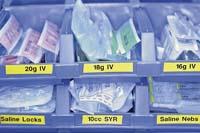
Biofilms may be attached to catheters and prostheses, so they can cause fungal infections in immunosuppressed patients.
Archive
The Medical Mycology team also investigates the most suitable drugs to destroy biofilms. To do this, in a collection of about a thousand fungi drugs are tested against various fungi. On the one hand, they are applied to isolated fungi in suspension of liquids --classically - and, on the other, on biofilms. During the research they have discovered that the drugs of the equinocandine family (anidulafungina, caspofungina and myafungina) are the most effective for attacking biofilms. On the other hand, it has been observed that drugs in the azol family, such as boriconazole, are ineffective in destroying biofilms, since they do not affect the biofilm that is formed, but are effective in preventive treatments.
However, the drug to be used in each case depends on the patient's condition. This study aims to make available to medical professionals sufficient data to analyze the positive and negative aspects of each of them, as well as tools to choose in each case the most suitable drug against fungi.
Summary:
The mycological medical team investigates severe mycosis (candidiasis and aspergillosis). They base their work on the development of mycosis and on biofilm research, study how they stick to different materials and test the effectiveness of endangered drugs.
Director:
Guillermo Quindós.
Working team:
Elena Eraso, María Villar, Cristina Marcos and Ilargi Miranda.
Department:
Immunology, Microbiology and Parasitology.
Faculty:
Medicine and Dentistry.
Financing:
Department of Education of the Basque Government and Medical Research Fund (FIS).
Website:
4.
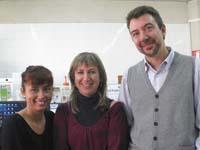
From left to right, Cristina Marcos, Elena Eraso and Guillermo Quindós. María Villar and Ilargi Miranda are missing in the photo.
(Photo: L. Alvarez)
Alvarez Busca, Lucia
Services
248
2008
Description
037
Universities; Medicine
Dissemination of knowledge
Other






